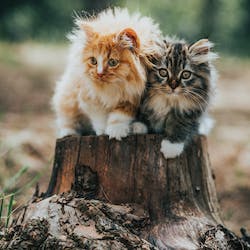
Level 1:
Cats can get sunburnt. Sunburn is not good for cats. Cats with light fur are more likely to get sunburnt. Cats with white ears or noses can also get skin cancer. Skin cancer is very bad for cats. You can keep your cat safe from the sun by not letting them stay outside for too long when it’s very sunny. You can also create shade for your cat and give them a comfortable indoor space with water.
Level 2:
It’s essential to acknowledge that cats are vulnerable to sunburn. Those with light-colored fur or areas with thin or no fur, such as white ears or noses, are more susceptible to sunburn and subsequent skin cancer. Sun damage can be detrimental to a cat’s health, leading to painful conditions and long-term health issues. Managing a cat’s exposure to the sun is crucial. Providing ample shade and ensuring they have access to indoor spaces with water will significantly reduce their risks of sun-related problems.
Full Story:
As the sun’s rays grow stronger during the summer months, concerns about cats and sun exposure arise. Contrary to popular belief, cats can indeed suffer from sunburn and its severe consequences.
Cats with light fur, particularly those with white or light-colored ears, noses, or patches, are more prone to sunburn. Prolonged exposure to the sun can cause painful burns and increase the risk of developing skin cancer. Skin cancer, when it develops, can be challenging to manage and severely impact a cat’s quality of life.
Recognizing signs of sunburn in cats is crucial. Look for redness, irritation, or peeling skin, especially in areas with less fur. If your cat exhibits these symptoms, it’s essential to seek veterinary advice promptly.
To protect your feline companion from sunburn, limit their exposure to direct sunlight, especially during peak hours when the sun’s rays are strongest. If your cat enjoys spending time outdoors, create shaded areas using trees, umbrellas, or other structures. Additionally, provide them with indoor spaces equipped with water and comfortable spots to rest.
Applying cat-specific sunscreen is an option but must be done cautiously. Always choose products specifically formulated for cats, avoiding any human or potentially toxic substances that could harm them.
Moreover, consider protective clothing designed for cats, like lightweight sun shirts or hats, to shield sensitive areas from direct sunlight.
In conclusion, cats are susceptible to sunburn and subsequent health issues caused by prolonged sun exposure. Pet owners should be vigilant in protecting their furry companions by limiting sun exposure, providing adequate shade, and creating indoor spaces equipped with water and comfort. Preventive measures play a vital role in safeguarding cats from the harmful effects of the sun.
Questions:
- Can cats get sunburnt?
- What are some signs indicating your cat may be suffering from sunburn?
- Why is limiting a cat’s exposure to the sun important?
- Do you believe using protective clothing for cats is necessary? Why or why not?
- In your opinion, what is the most crucial step a pet owner can take to shield their cat from sun damage?
Fill in the Blanks:
-
vulnerable, irritation, toxic, veterinary, cat-specific, precautions, hydrated, exposure
-
Cats with light fur, particularly those with white or light-colored ears, noses, or patches, are more __________ to sunburn.
-
Look for redness, __________, or peeling skin, especially in areas with less fur.
-
Applying __________ sunscreen must be done cautiously, ensuring it’s formulated specifically for cats.
-
In conclusion, pet owners must take necessary __________ to safeguard their cats from excessive sun exposure.
Vocabulary:
- Vulnerable: susceptible to physical or emotional harm.
- Irritation: a state of inflammation or painful reaction to something.
- Toxic: poisonous or harmful to living organisms.
- Veterinary: relating to the medical care and treatment of animals.
- Cat-specific: designed or suitable for cats specifically.
- Precautions: measures taken in advance to prevent harm or danger.
- Hydrated: having sufficient fluid or moisture.
- Exposure: the condition of being subjected to something, especially something harmful or difficult.




